

Creativity and Schizophrenia Spectrum Disorders Across the Arts and Sciences. Researchers agree that mental illness is neither necessary nor sufficient for creativity.
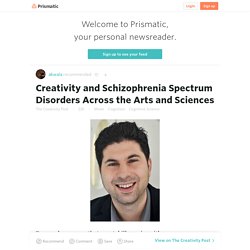
But is there still a significant link between the two? 1The Imagination Institute, Philadelphia, PA, USA2Positive Psychology Center, University of Pennsylvania, Philadelphia, PA, USA3Department of Philosophy, Barnard College, Columbia University, New York, NY, USA. The Real Link Between Creativity and Mental Illness. This has important implications for creativity.
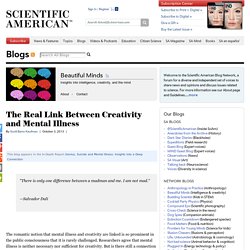
Mark Batey and Adrian Furnham found that the unusual experiences and impulsive nonconformity dimensions of schizotypy, but not the cognitive disorganization dimension, were significantly related to self-ratings of creativity, a creative personality (measured by a checklist of adjectives such as “confident,” “individualistic,” “insightful,” “wide interests,” “original,” “reflective,” “resourceful,” “unconventional,” and “sexy”), and everyday creative achievement among thirty-four activities (“written a short story,” “produced your own website,” “composed a piece of music,” and so forth). Recent neuroscience findings support the link between schizotypy and creative cognition.
Hikaru Takeuchi and colleagues investigated the functional brain characteristics of participants while they engaged in a difficult working memory task. Genius, Suicide and Mental Illness: Insights into a Deep Connection. Drug Unlocks Malleable, Fast-Learning, Child-LIke State In Adult Brain. A Natural Fix for A.D.H.D. Photo ATTENTION deficit hyperactivity disorder is now the most prevalent psychiatric illness of young people in America, affecting 11 percent of them at some point between the ages of 4 and 17.
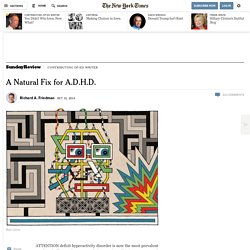
The rates of both diagnosis and treatment have increased so much in the past decade that you may wonder whether something that affects so many people can really be a disease. The Reinvention of the Self. Elizabeth Gould Photography by Reynard Li Professor Elizabeth Gould has a picture of a marmoset on her computer screen.
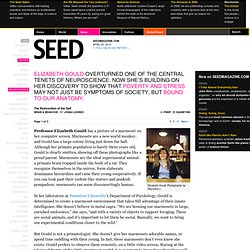
Marmosets are a new world monkey, and Gould has a large colony living just down the hall. Although her primate population is barely three years old, Gould is clearly smitten, showing off these photographs like a proud parent. Marmosets are the ideal experimental animal: a primate brain trapped inside the body of a rat. They recognize themselves in the mirror, form elaborate dominance hierarchies and raise their young cooperatively. In her laboratory at Princeton University’s Department of Psychology, Gould is determined to create a marmoset environment that takes full advantage of their innate intelligence.
Brain-Training Games Don't Actually Make You Smarter. A decade ago, a young Swedish researcher named Torkel Klingberg made a spectacular discovery.

He gave a group of children computer games designed to boost their memory, and, after weeks of play, the kids showed improvements not only in memory but in overall intellectual ability. Spending hours memorizing strings of digits and patterns of circles on a four-by-four grid had made the children smarter. The finding countered decades of psychological research that suggested training in one area (e.g., recalling numbers) could not bring benefits in other, unrelated areas (e.g., reasoning). You’re probably an optimist (but we can fix that) The classic cliché—are you a glass half-full or half-empty person?

—is actually a trick question. We're all half-full, to a certain degree. Various studies have defined a "good news-bad news" effect, in which people are less likely to incorporate bad news into their thinking compared to happier information. You're far less in control of your brain than you think, study finds. You've probably never given much thought to the fact that picking up your cup of morning coffee presents your brain with a set of complex decisions.

Hemispheric Disturbances: On Michael Gazzaniga. If our brains act according to the causal laws governing all matter, in what sense can we be said to be free?

We live in the age of the fMRI machine, dazzled and bamboozled by pictures of brains “lighting up” in living Technicolor. Before these neuroscientific glory days, the mysteries of the mind had to be approached by rather less alluring methods: postmortem examination of the brains of psychiatric patients, animal experiments of legendary cruelty and intelligence testing after pioneering brain surgeries, to name but a few. During the knife-happy decades of the mid-twentieth century, surgical treatments for seizure disorders generated especially startling insights into human brain function. Who’s in Charge? Free Will and the Science of the Brain. About the Author. Humans Make Language, Language Makes Us Human. In this excerpt from his linguistics lecture for the Floating University, Steven Pinker illuminates some of the mysteries surrounding children’s hardwired ability to learn language.
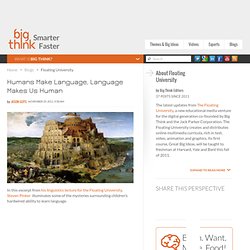
What’s the Big Idea? Language is so central to everything we are and do from toddlerhood on that unless you are a) a linguist or b) right now raising a toddler it’s easy to forget just how amazing our capacity to produce and decode speech actually is. Brain scan shows rejection pain. Being snubbed socially provokes exactly the same brain response as being physically hurt, say US researchers.
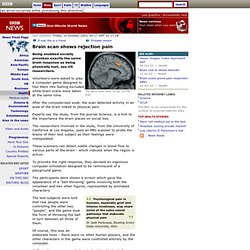
Volunteers were asked to play a computer game designed to fool them into feeling excluded, while brain scans were taken at the same time. After the computerised snub, the scan detected activity in an area of the brain linked to physical pain. Experts say the study, from the journal Science, is a hint to the importance the brain places on social ties. The researchers involved in the study, from the University of California at Los Angeles, used an MRI scanner to probe the brains of their test subject as their feelings were manipulated.
These scanners can detect subtle changes in blood flow to various parts of the brain - which indicate when the region is active.
Developing Intelligence : Caffeine: A User's Guide to Getting Optimally Wired. Caffeine is the most widely used stimulant in the world, but few use it to maximal advantage. Get optimally wired with these tips. 1) Consume in small, frequent amounts. Between 20-200mg per hour may be an optimal dose for cognitive function. 'Stumbling on Happiness' by Daniel Gilbert - The New York Times Book Review. Review: Stumbling on Happiness. Psychology. Gtd. Wired 13.02: Revenge of the Right Brain. Logical and precise, left-brain thinking gave us the Information Age.
RSA Animate - The Divided Brain. On early birds and night owls - Ars Technica. As a night owl myself, I look at those who are bright and chipper early in the morning and think "why? " To me, being awake and functioning before 10am is fairly difficult to comprehend. Even looking back on my life, I have no idea how I managed to wake up, clean up, and drive the 30 minutes into the city each day for four years in high school.
Yet others will look at me with puzzlement when I state my usual bedtime—many of my Nobel Intent contributions have come from after midnight. A new study, carried out by a team of Belgian and Swiss researchers and published in last week's issue of Science, looked at the underlying cause of what makes one an early bird or a night owl, and what effects this has on day-to-day life. The study consisted of 31 participants, 16 morning people, and 15 night owls—the night owls' days were shifted an average of four hours later than those of the early birds.
Why Migraines Strike. For the more than 300 million people who suffer migraines, the excruciating, pulsating pain that characterizes these debilitating headaches needs no description. For those who do not, the closest analogous experience might be severe altitude sickness: nausea, acute sensitivity to light, and searing, bed-confining headache. “That no one dies of migraine seems, to someone deep into an attack, an ambiguous blessing,” wrote Joan Didion in the 1979 essay “In Bed” from her collection The White Album. Historical records suggest the condition has been with us for at least 7,000 years, yet it continues to be one of the most misunderstood, poorly recognized and inadequately treated medical disorders. Indeed, many people seek no medical care for their agonies, most likely believing that doctors can do little to help or will be downright skeptical and hostile toward them. Select an option below: Customer Sign In.
The Mirror Neuron Revolution: Explaining What Makes Humans Social. Marco Iacoboni, a neuroscientist at the University of California at Los Angeles, is best known for his work on mirror neurons, a small circuit of cells in the premotor cortex and inferior parietal cortex. Brain Rules: 12 Principles for Surviving and Thriving at Work, Home, and School.